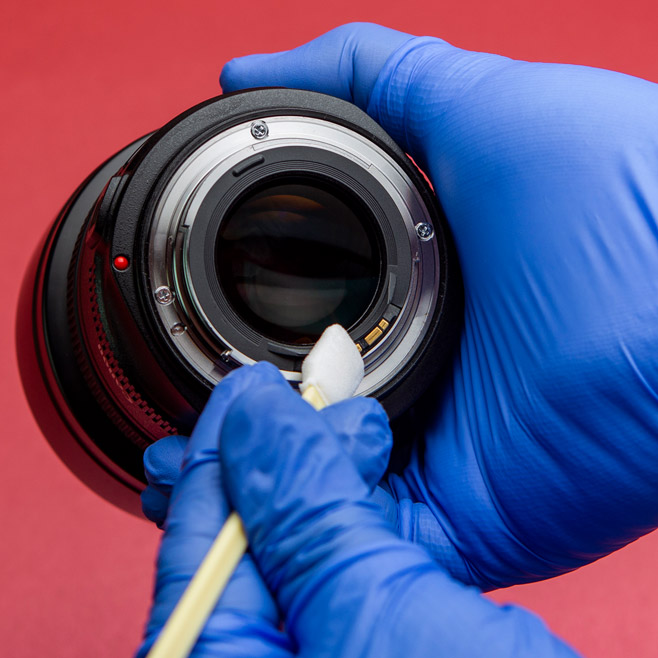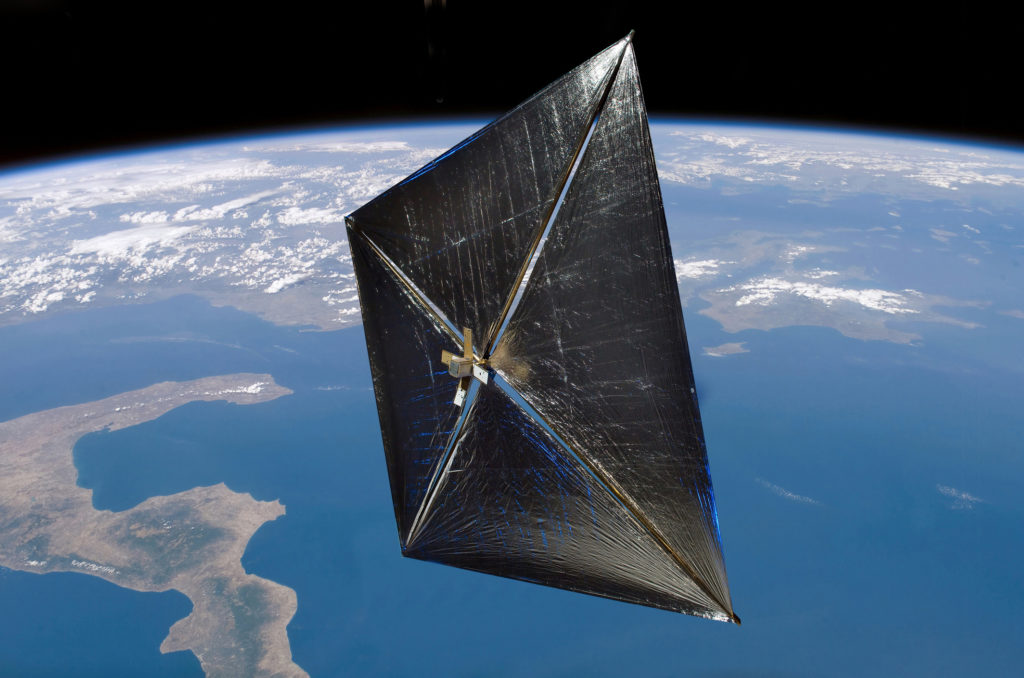Aerospace, Cleanroom News
How Photon Sails Are Powering CubeSats Across the Final Frontier
For readers who keep up to date with new issues in psychology (we know, but bear with us…) a recent discussion of megalophobia must have been of some interest. Megalophobia is a disorder defined as the fear of large objects, or objects that are perceived as being larger than they ‘should’ be. An example could be the kinds of mega cruise ships that now ply the waterways of the Caribbean or Pacific or an animal that doesn’t fit the image the sufferer normally associates with it. So with these folks in mind, we are delighted to report that not all spectacular things are super-sized. Some are, in fact, perfectly small. In a list published by Mashable, exciting gift ideas for lovers of miniaturization include not only the traditional – Zen Garden desk sets, for instance – but the eminently useful – the tiny TSA-friendly Cocktail Kit – and the singularly bizarre – world’s smallest quadcopter, with diminutive items sold as all the rage. Even Amazon is in on it – need a ‘tiny house’? They’re available online! But when we’re not relaxing with a Lilliputian Zen Garden or leveraging a pocket-sized quadcopter to deliver miniscule mojitos to our coworkers, we’re thinking about CubeSats. Remember CubeSats?
‘I saw a flyer on a bus stop that said, “Want to build a satellite?”’ and suddenly her career path was revealed
We wrote about them back in December 2016 in our analysis ‘CubeSats? In Space Exploration, Less Just May Be More’ and looked at their development in the late 1990s by Bob Twiggs of Stanford University in conjunction with California Polytechnic State University’s Jordi Puig-Suari for use in ‘low-earth orbit satellite [to] perform specific research tasks for both the commercial and academic sectors.’(1) The original concept for the CubeSat was a picosatellite – small and inexpensive enough that they could be created via additive manufacturing by undergraduate and graduate students. In fact, according to an article published by National Public Radio last week, it was a decidedly low-tech initiative that propelled then undergraduate student Hannah Goldberg to choose engineering as her academic focus: ‘I saw a flyer on a bus stop that said, “Want to build a satellite?”’ and suddenly her career path was revealed – Goldberg now works for GomSpace, a private company in Denmark that engineers the devices for the European Space Agency.(2) (An interesting sidenote: a quick perusal of GomSpace’s website sees their corporate vision as it relates to space missions as ‘To understand the Universe.’ No blue-skying there then…)
But what inspired Goldberg and other scientists like her to put so much faith in something so diminutive and – let’s face it – non-specialized? After all, can serious science really be performed by a device created completely from ‘off-the-shelf’ components? This is a question that has troubled other researchers such as Barbara Cohen of NASA’s Goddard Space Flight Center in Greenbelt, MD. When considering the early days of CubeSat development Cohen worried about long-term viability and that the devices would just become space junk, a danger to ‘real’ satellites in orbit. But in the age of miniaturization – and especially of advances in smartphone technology – the future for CubeSats looks amazingly bright. Cohen is now the Principal Investigator for a mission termed ‘Lunar Flashlight,’ which is based at NASA’s Jet Propulsion Labs in Pasadena, CA. At the Integrated CubeSat Development Laboratory, a 6U-CubeSat (basically 6 units stacked together) is being engineered to go a little further than the usual low-Earth orbit of the sats Generation One. The original devices weighed in at only around 3lbs and were engineered as the perfect payload for missions to record data on weather research, extremely-low frequency (ELF) earthquake emission data, and the like. And not only were they portable but also cost-efficient: ‘Where the costs associated with deploying a full-sized satellite represented an insurmountable financial obstacle, the launch of a CubeSat as secondary payload offered a lower-budget alternative.’(4) The 6U devices, however, resemble less the conventional Rubik’s Cube and more a family-sized box of breakfast cereal. And though small, the reach of this space explorer is broad – in fact, it is set to visit the far side of the Moon to inspect for water. Temperatures within craters on the Moon’s south pole plummet to around 35 degrees above absolute zero and the hope is that they may contain water. Shining a laser into the depths of the craters, the 6U craft will measure light reflection and thereby determine the presence or otherwise of water. And this is not a matter of idle curiosity: if water is indeed found on our closest neighbor, we may be one step further along the path toward deeper exploration of our solar system.
But if these units are so very small and the distances through space are so very great, how do they travel? Great question!
Ever heard of solar sails? In essence, just imagine a large kite made of thin-film reflective material that harnesses the power of light, as opposed to wind, to propel a craft. Also known as ‘light-’ or ‘photon sails,’ the apparatus gains momentum as particles of light hit it. Reflecting these photons back from the canopy’s mirror-like surface, the sail receives a slight nudge which, in the vacuum of space, is sufficient to push the craft on its way. According to the Planetary Society, an organization founded in part by Carl Sagan and now led by Bill Nye to generate citizen interest in space exploration, sails are engineered from materials like Mylar, which can be just 4.5 microns (1/5000th inch) in thickness, and coated with a metallic reflector.(5) This may sound flimsy and, without a concrete example of a photon sail in use, it’s not hard to be skeptical. Which is why we were thrilled to read about ‘Lightsail 2,’ the Planetary Society’s crowd-funded mission which put a spacecraft with such a sail into orbit in June this year. And the truly exciting part of the story? The Planetary Society assesses that the use of the mylar sail has raised ‘[the craft’s] apogee, or orbital high point around the Earth, by 7.2 kilometers—all without a drop of conventional fuel.’(6) Theoretically, sailing on light could allow us to go further and faster than conventional fuel-based rockets, increasing our reach out into the universe.(7)
But could there be a dark side to this potential new ability to travel ever further into the cosmos? Perhaps. At JPL, researchers involved in the Near Earth Asteroid Scout (NEAScout) project are developing a CubeSat with a light sail for launch in 2020. The satellite ‘will flyby and observe a small asteroid (<300 feet in diameter), taking pictures and observing its position in space, the asteroid’s shape, rotational properties, spectral class, local dust and debris field, regional morphology and regolith properties [with a view to] directly assist in retiring the unknowns related to human exploration of asteroids and planetary small bodies.’(8) In other words, NEAScout is tasked with eliminating ‘unknowns’ ahead of human-powered missions to similar small planetary bodies. Or perhaps even to Mars.
And because setting foot on Mars is the current dream of many pioneers of space travel one aspect is critical: preserving the pristine environment of our extraterrestrial neighbors. In an international agreement stipulating that ‘exploration must be conducted in a manner that avoids harmful contamination of celestial bodies,’ NASA has long been active in the field of creating Planetary Protection Technologies (PPT).(9) In the case of its Mars Rovers, for example, the agency is limited to a total of 300,000 bacterial spores per craft, with pre-flight engineers dedicated to frequent cleanings of component surfaces with an alcohol solution, heating parachutes and thermal blanketing materials to a minimum of 110 degrees Celsius (230 Fahrenheit), and isolating the core electronics and venting through high-efficiency filtration systems.(10)
But will this be enough to ensure a contamination-free mission or is there a vector of contamination that we have overlooked?
In our article ‘Should Cellphones Be Allowed in a Cleanroom?’ we examined the ways in which our tools of communication could be significant vectors of contamination. And we also noted that many cleanroom facilities explicitly prohibit the presence of such items within the sterile environment. After all, these are devices that we take with us everywhere from the bedroom to the restroom, and few of us would consider them to be contamination-free. Therefore, while viewing with interest a video from a cleanroom in Huntsville, AL, we were most concerned to note the use of hand-held cellphones. The video, published by NASA, shows the test deployment of a solar sail intended for the NEAScout, and clearly depicts engineers, fully garbed in personal protective equipment (PPE), using cellphones to record images for posterity. Yes, we understand that this is simply a test deployment, but nonetheless we do worry that it could be a sign of a concerning lapse. As we mentioned in our previous piece, some institutions regard the intrusion of cellphones into a sterile environment as being on a par with the wearing of open-toe shoes – something that would realistically never happen – so we’re scratching our heads at their presence in this case.
But what impact could the contamination of equipment such as a light sail have on a mission to, say, an asteroid?
According to an article in The Verge, a report from the National Academies of Sciences, Engineering, and Medicine emphasized that NASA must tighten up its policies around planetary protection. The original international agreement regarding the prevention of extraterrestrial contamination, the Space Treaty, was ratified by 105 countries but, at more than half a century old, is now woefully outdated. Moreover, 21st century space missions are unfathomably more complex than those of 50 years ago and there are more players in the field. While NASA voluntarily conforms to the Committee on Space Research (COSPAR) guidelines on minimizing contamination from bacteriological, microbial, fungal, and other particulate sources, these rules were not drawn up in an era of private enterprise where companies such as SpaceX are also eyeing the Red Planet. This is not to say that the company and others like it will not conform to COSPAR – just that they are not legally obliged to.
Furthermore, it’s not just what we take to the Moon, or Mars, or Jupiter’s moon Europa that should worry us. It’s also what we might inadvertently bring back. In popular culture, when we generate a narrative of man’s annihilation by extraterrestrial forces we tend to dwell on devastating impacts of asteroids (remember the movie Armageddon?) or of beings come to enslave us (viz, The War of the Worlds and V). But what could be more likely is that future space invaders arrive on our planet via human hosts who, unknowingly, return home bearing more than just data and memories. Given that ‘people are extra messy creatures,’ we are more at risk of microbial or bacteriological foes – and these are enemies against which we would have little protection.(11)
This is, of course, why calls are being made for agencies such as NASA to work hand in (sterilized) glove with private enterprises such as SpaceX to put in place an updated and significantly more robust set of guidelines and protocols for planetary protection.
Incorporating the recommendations of experts in the fields of microbiology, astrobiology, and genetics to create a picture of the types of contaminants most likely to survive an interplanetary journey, the new guidelines would be submitted to the US Commerce Department which would then grant licenses to those private entities with the required SOPs. How exactly the Commerce Department would oversee conformance is, as yet, unclear.
What is clear, however, is that advanced space travel – be it for purposes of tourism, exploration, mining, or extraterrestrial colonization – is peppered both with significant challenges and rewards. And the precautions we take to safeguard the worlds across the divide of what is arguably the most significant, and most thrilling, of frontiers should be approached with infinite reverence and patience. Let’s watch developments very closely so that we never run the risk of mistakenly jeopardizing those unique environments that we are only now on the very brink of discovering.
Do you have experience with solar sails? How far do you think this technology will advance the exploration of deep space? Are you concerned about interplanetary contamination? We’d love to hear your thoughts!
References:
- https://staging.berkshire.com/cleanroom-news/cubesats-less-just-may-be-more/
- https://www.npr.org/2019/10/23/772024008/itty-bitty-satellites-take-on-big-time-science-missions
- https://cleanroom-news.com/2016/12/cubesats-less-just-may-be-more/
- ibid
- https://www.planetary.org/explore/projects/lightsail-solar-sailing/what-is-solar-sailing.html
- https://www.planetary.org/blogs/jason-davis/ls2-one-month-sailing.html
- And for all interested armchair astronomers, thanks to the reflectivity of its photon sail The Planetary Society’s ‘Lightsail 2’ can be seen in the night sky within 42 degrees of the Equator. Just another reason to bundle up and step outside to take a look for that shining celestial body…
- https://www.jpl.nasa.gov/cubesat/missions/neascout.php
- https://mars.nasa.gov/mer/mission/technology/planetary-protection/
- ibid
- https://www.theverge.com/2018/7/5/17532638/nasa-planetary-protection-mars-europa-spacex-contamination




















HAVE AN IDEA FOR CONTENT?
We are always looking for ideas and topics to write about.
Contact Us